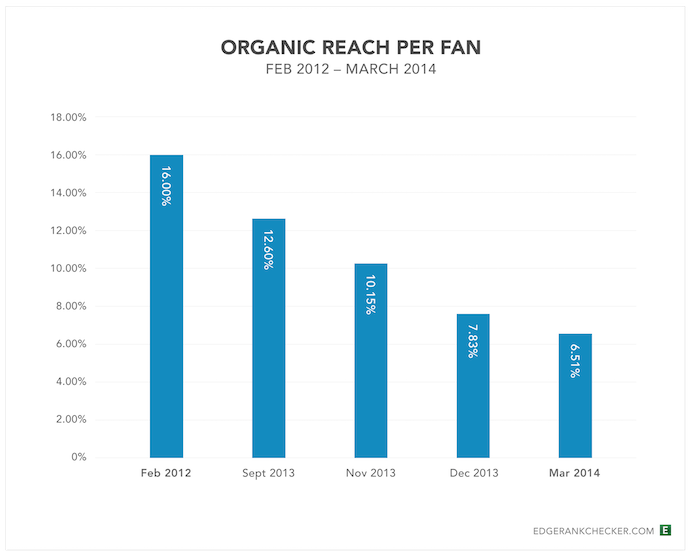In case you’ve been managing a Facebook Business Page over the previous few years, you have probably noticed a decline in how many of your followers have been viewing and interacting with the organic Facebook reach posts you publish to that page.
Why Your Organic Reach Has Declined on Facebook Reach
More Ad Content Competing for News Feed Space
This observed decline in organic Facebook reach started in 2014, when Brian Boland, Facebook’s VP of Advertising Technology (at the time), stated Facebook is solely managing more advert content than it used to, and News Feed space is thus more competitive among marketers.
Boland, now Facebook’s VP of Publisher Solutions, is right. There’s merely too much content being published on Facebook, making visibility within the News Feed increasingly aggressive. And Facebook strives to show individuals the content that’s most relevant to them, versus surfacing all the content available.
Facebook’s 2018 News Feed Change
More recently, you have noticed a greater dip within the organic reach of your Facebook content due to a necessary change to Facebook’s News Feed algorithm.
In January 2018, according to Facebook’s Head of News Feed Adam Mosseri, Facebook began to “shift rating to make News Feed more about connecting with individuals and less about consuming media in isolation.”
Consequently, marketing content poise to take a backseat to content by family and friends. A value that Facebook says it initially had, and that it is trying to return to.
The good news in all of this is you can do to counteract these adjustments, like being extra selective about what you publish, paying attention to once you publish, and putting money behind your posts (a.k.a. “boosting” them).
Before we dive into how one can enhance your Facebook Page’s organic reach and reengage your Facebook followers, let’s discover precisely how Facebook’s News Feed algorithm works. Then, we’ll see how various algorithm adjustments — together with its 2018 update — have affected the reach of a marketer.
How Facebook’s News Feed Algorithm Works
When Facebook first launched News Feedback in 2006, the algorithm was fairly basic. Different post formats were assigned different point values. So a post with simple text could be worth one point, whereas a post with a link in it may be worth two points, and so on. By multiplying the post format point value by the variety of individuals interacting with a given post, Facebook may generate a rating system for figuring out the order in which posts would appear.
Because the years rolled on, the News Feed algorithm evolved to factor within the recency of posts, in addition to the relationship between the individual doing the posting and the individual interacting with said post. However, in 2011, Facebook abandoned EdgeRank for an extra complex algorithm that includes machine learning.
That machine learning-based algorithm is what’s answerable for surfacing content in your News Feed today. Not like its predecessors, which assigned generic point values to post formats, the present algorithm adapts to individual personal preferences. So, for instance, when you never, ever, work together with pictures in your News Feed, Facebook’s algorithm will pick up on that and present you fewer images over time.
However, Facebook has recognized for marketers the content formats that drive engagement and sharing — native and live videos. Facebook ranks live videos higher within the News Feed, in addition to videos with higher watch and completion rates and videos that might be clicked on or unmuted as signals of viewer interest.
Ultimately, there are thousands of components that inform Facebook’s algorithm of a significant interaction. These components range from utilizing trigger words that indicate necessary occasions (e.g., “congratulations”) to whether or not you have really clicked a link in a post before liking it.
What Is Facebook Reach and How Has It Modified?
Facebook defines organic reach as “how many individuals you may reach without cost on Facebook by posting to your Page.” Prior to 2012, that quantity used to be much, much higher than it’s now.
2007-2012: Fan Pages
From the moment “Fan Pages” launched in 2007, anybody may create a Page for their firm or organization. They can begin gathering followers and post unlimited messages with the idea that they might see these messages.
When 2012 rolled around, Page managers learned that solely a fraction of their Facebook followers — 16% on average — had been seeing their Page posts of their News Feeds. And that fraction received considerably smaller in 2014.
2014: Organic Reach Plummets
A study from Edgerank Checker discovered that organic reach for the typical Facebook Page dropped from 16% to 6.5%. Research from Social@Ogilvy, meanwhile, suggests that for Pages with more than 500,000 Likes, organic reach might be as low as 2%.
Picture via Biznology
Base on the figures above, meaning a Page with 10,000 followers may expect just 650 of them to actually see that Page’s posts on their News Feed. For a Page with 1 million followers, about 20,000 would end up seeing posts (based on the 2% figure).
2016: Reintroducing Friend and Family Content
SocialFlow analyzed more than 3,000 posts by publishers on Facebook and found that organic reach dropped 42% between January and May 2016.
Then, later in 2016, Facebook adjusted its News Feed algorithm again, to additional prioritize content. This probably makes News Feed’s present condition less surprising …
Within the blog post announcing the algorithm change, Facebook Engineering Director Lars Backstrom warned that Pages may anticipate a dip in organic reach — which may leave reach lower than that earlier 2% estimate, in some instances.
After this algorithm adjustment, SocialFlow adjusted the decline in organic reach — which had dropped additional. Between January and July 2016, publishers saw a 52% decline in organic reach on Facebook.
2017: Discover Alternative News Feed
Facebook’s greatest algorithm update for 2017 wasn’t an algorithm update, however, rather a new News Feed completely.
In October of that year, Facebook tested an ad-free News Feed that customers may change. It devoted to publisher content rather than private content. To manufacturers, it clearly foreshadowed a Facebook that separated Pages content from family and friends content. Today, that “alternative News Feed” is called the “Pages” option on the lefthand sidebar of a person’s News Feed.
Just days after Facebook launched this different News Feed test, a social media supervisor for a newspaper in Slovakia reported that 60 of the largest media pages within the country saw their likes, comments, and shares decrease fourfold.
2018: Reinforcing That Commitment to Friends and Family
Facebook’s recent incident of data misuse by analytics agency. Cambridge Analytica, which prompted Facebook to deeply handle the privacy of customers in various methods.
However, this process was preceded by an identical yet unrelated News Feed update to focus less on content. This update to Facebook’s News Feed algorithm would not eliminate Page content from News Feeds completely. However, this update does set different priorities for which content will get prime News Feed real estate.
In accordance with a private Facebook webinar hosted in January 2018, these priorities are:
- If the content is shared over Facebook Messenger.
- In case the content is Liked or commented on.
- If the content receives a number of replies.
- “Significant interactions” between customers.
Shares and comments, particularly, are “active” interactions, which Facebook considers extra “meaningful” when slotting content on a person’s News Feed. For that reason, the company notes that video watch time, referral traffic, and organic reach may decrease this year if the content doesn’t stir up a significant interaction.


